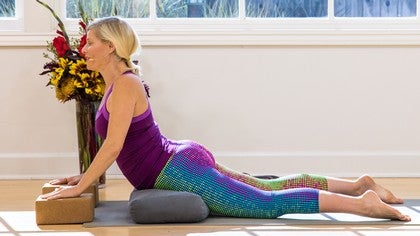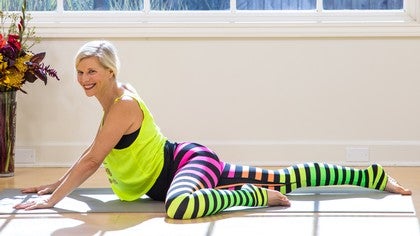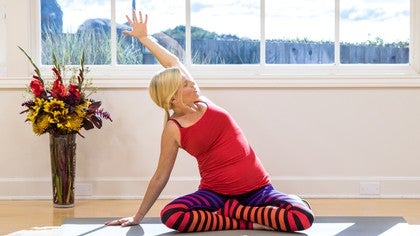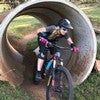Description
Transcript
Read Full Transcript
Hello, yogi friends. I'm so glad you're going to practice with me today. So let's get started. So we're going to start off in dragon pose and it'll be about a two minute hold. So I'm stepping my right foot forward first and I'm going to just start to lean into my right leg.
So again, we're here about two minutes and I'm stretching the front of my left thigh where the pelvis and the thigh meet. So this is like the hip flexor area. So if you've been sitting too long or if you, that could be like in a desk or in a car. This is a nice pose to open up the front of the hip. And this area of the body, keep in mind, this is not just a stretch for the muscles.
This is a major place of blood supply in the body. So the femoral arteries, femoral vein, femoral nerve run through this area. So we're just starting to really open up this area and you can see, well, maybe you can't see, but I'm feeling it. I'm feeling myself dropping a little deeper, so I'm going to lower the blocks. You certainly don't need to be using blocks here.
And while yin is a more static type of yoga, you really can move a lot if you need to. So this is like the way I tell people to move in yin is imagine that you're seaweed at the bottom of the ocean. So you're being moved by the currents around you. To control the breath is more yang. So in a yin class, we just really let the breath be what it wants to be.
You certainly can control the breath, so I'm going to move these out and start to come even lower. And keep in mind as well, this shape is your own shape, so you're looking for a stretch at the front of the left thigh where the pelvis and the thigh meet. You might have stayed higher up on the blocks. You could even lift an arm up and twist a bit if you want. And then we're just going to start to move ourselves out of the pose, easing our way out of dragon.
We're going to come right into half saddle pose, so I'm straightening my right leg and bending my left knee, and just be real gentle in this transition. You can take your time. So I'm going to bring my bolster behind my back. You don't have to use a bolster. And I line my bolster up right about at the back of my hip, and then just start to lean back.
Sometimes people like a block under their head, we'll see if I do today. So I'm going to lie back, and we're here for about three minutes. So I could put a block here under my head, I'm just going to let my head lie back. So we're here about three minutes. So before we were opening up the front of the left thigh in the dragon pose, and we were more getting into the hip flexor area, now we're starting to get into the quadricep.
So the muscle's at the front of the thigh. There's four quadriceps, and they actually come down, and the tendons of the quadricep, the kneecap, the patella is embedded in the tendon of the quadricep. So you might feel this stretch a little bit at the front of the knee. And again, just letting the breathing be really natural. You certainly could bring your arms overhead if you want to.
And sometimes when you bring your arms overhead, you might feel more of a stretch in the abdomen, kind of opening up in the diaphragm area. So the diaphragm at the base of the ribcage. And this is also a really great back bend. So again, if you've been sitting too long in the car, and you've been in this place of flexion, you've been in a forward fold most of your day in a car or at a desk, just sitting in a chair, anywhere, you've been in a state of flexion in the body. So this is extension, which is back bending.
I like to close my eyes. You certainly can keep your eyes open if you want. So the only part of this pose you might want to be concerned about when you're in these poses is the knee. Certainly you don't want any of the yin poses to hurt the knee. So especially being aware of the medial or the inner knee, the medial aspect of the knee.
Just come out of the pose if it starts to bother you. And just really trying to feel the whole body relax here. Maybe just one or two more deep breaths. And we'll just start to ease ourselves out of the pose. So I like to come up to come out.
Some people just slide their leg out from under them, but I'm going to just start to ease my way up. There's not really a pretty way to come out of this pose. And then just gently unravel the legs and maybe give them a little shake. So I can already feel that the blood supply is different. The circulation is different in my legs.
All right, so I'm going to switch it over to the other side. Now we're going to take it onto our left leg forward. So coming into dragon pose. So the left leg comes in front. I'm going to bend into my left knee and remember I'm starting off with the blocks high and I'm getting a stretch at the front of the right thigh now.
So on this side, I'm a little more open so you can see I'm already starting to be able to bend back, bend a little bit more. And maybe that's also because I've already warmed up my spine a little bit with that half saddle, but we're here about two minutes. So the more you take this into a back bend, the more you might be able to access the psoas muscle, which is a muscle that goes from the femur to the lumbar spine. So taking it a little bit more into a back bend, if that feels comfortable for you, really might accentuate the stretch and just feeling the length up through the front of the spine might feel really nice. But certainly you're welcome if the pose is more comfortable for you to already be down like on the forearms.
People could certainly already be down on the forearms and as well, you might notice my knee is going in front of like it's in line with my toes. Sometimes I can even do it and I'll show you move the block a bit, but sometimes I even do this pose with the knee really far forward. It's okay to do that, to let the knee move beyond the toes and it gives a nice stretch stimulation to the ankle. Wake up the Achilles tendon a little bit. Sometimes actually doing this pose makes me sweat a little bit, makes me a little hot.
So this is one of the more young of the yen poses. Maybe one more deep breath here, just feeling that link through the front of the spine and then just ease yourself out of it. So I'm going to start to straighten my left leg and bend my right leg. Notice I'm going really slow. You kind of feel almost as if your body is like an antique when you come out of these poses and you should just let yourself be in that state of vulnerability.
You feel vulnerable and fragile and it's not a bad thing. And I'll explain that more in a moment. So we're going to lean back into our half saddle, again, staying with the stretch in the right leg. So we're stretching the front of the right thigh. You could bring a blanket or a block under your head.
You could do without the bolster entirely. We're going to be here three minutes. And I didn't say this on the other side, but if this bothers the knee, say you have a knee injury on one side and you don't want to do this pose this way, you could just come into like a seated tree pose. So I could bring my right, the sole of my right foot into my left inner thigh. And then just really try to relax here.
So in Yen, we're not working so much with the muscular structure. I do refer to the muscles, but we're more trying to really release the muscles and sink into that deeper layer of fascia. And fascia is ubiquitous in the body, meaning it's everywhere. So it's like you're communicating with the whole body to help bring yourself into a place of stillness. Basically you're learning to relax.
For someone like me who is faster, you know, I tend to talk fast, I move fast. My brain goes very fast. Pain has been a challenging practice, but a very beneficial practice. So about now, I start to really try to let go of my spine and just feel the spine really release. Sometimes we just have residual tension in the spine.
So give your spine permission to let go, to just completely relax. And if you have tension in the face or the jaw, really try to relax that, maybe even like separate the back teeth. Relax the eyes and the forehead and see if you can actually feel that the muscles are releasing their grip on the bones. I like to think of it as getting heavy in a good way. You might just take one or two more breaths here and just really let yourself release.
It's nice in those final breaths to just totally let go and then just start to ease yourself out. And in other words, you can come out any way you want. You can roll to the side, you can come up this way and then just unravel that right leg and maybe give it a little shake. You can forward fold a little bit. It's nice to rebound for a moment though and just a place of stillness, so you just take a moment to just be still and breathe.
So we're going to move into a standing position, into a dangle posture. So I'm going to roll forward onto all fours and come into like a tabletop position. And then I'm actually going to press back into down dog. So if you've been sitting a while, it might feel good to just kind of open up the backs of the legs first and just give a little pedal, a little bit of movement. You don't have to do this if you're really staying with the whole theme of just being very, very yin.
But remember, I'm just doing this in a yin fashion, meaning I'm doing it very gently. I'm doing it in a passive way. I'm not being aggressive. I don't really have much of an agenda. And then I'm going to come into dangle posture.
So I'm just letting my head drop down. Notice I just walked my feet in or walked my hands back. And now I'm just letting the back of the legs open up. So we're going to be here about three minutes. You could do this shorter or longer, of course, but I think three minutes is a really nice amount of time for this pose personally.
I'll be honest, I actually do this like when I'm waiting for water to boil. I've even been known to do this when I'm waiting for gas to pump. And so you can do this as a stretch like it's not too weird looking. In other words, you don't look too strange doing this a little bit, but not too strange. You also can bend your elbows and bring your forearms to your thighs if that feels more comfortable and just try to really release through the back of the neck.
So I notice in my students that, and I read a lot about biomechanics and posture, and we tend to overuse the back of the neck. So just really letting the back of the skull release. And then other times as well, people who have a lot of neck tension or shoulder tension, sometimes even just gently resting the hands on a block or a bolster, it just props the shoulders, the arms up so that the shoulders are relaxed a bit more. And my knees are soft right now, but you certainly could straighten your legs all the way. I'm straightening mine now to just really, it intensifies it for me.
To just really get into the back of the leg. So I talked about the blood supply to the leg earlier. It goes down the front of the hip, then it, it crosses, it goes in the inner thigh and then it crosses to the back of the knee to go down to the lower leg. So keeping the openness in the back of the knees is really great here as well, especially if you've been sitting for a long time. Giving a nice stretch to the hamstrings at the back of the thigh.
I feel this in the lower leg too, like in the calves. The soleus gastrocnemius, the two big muscles of the calf. And I also will say, I mean, certainly I'm feeling traction on the spine, so let the head be like a bowling ball here, you know, let it be nice and heavy so that you're really releasing the skull and letting the traction happen all throughout the spine. And a lot of times I also notice my feet get tense. So try to really relax down through the feet and maybe pay attention.
This is a little more young, but pay attention to some of the patterns in your feet. Like are you rolling to the outer edge? Are you way back in the heels? Are you leaning forward and gripping in the toes? Can you find a place where the foot can relax so that the shin bones can release down into the floor?
That's the sensation I feel at least. So we're going to start to slowly roll up. So I'm going to soften my knee joint. You could do this using your hands if you want. I'm going to do it without my hands and soften the knees.
And I'm just I'm using the pelvis like a crank. So my belly is actually pulling up into the spine and I'm rolling up slowly just to stack the spine. Usually this is a really nice feeling at the top. Just like a little brief standing shavasana. So we're going to do some movement for the upper body.
And feel free to pause it and take time. If you ever are having a really nice experience in between poses, I would pause it. I just want to keep those moving who are wanting to keep moving. So we're going to use a strap. You could use a scarf if you're at home and don't have props.
I'm going to use a strap, but certainly, like I said, I often just travel with a scarf and I'll use a scarf for a lot of my stretches. So you don't have to have a special yoga strap. So I've folded it in half. I've opened it all the way and folded it in half, mostly just so it'll be out of my way. And so I'm not going to wrap it around my neck or anything like that.
And then I'm just going to bring my arms up and over and start to open through the chest. So you could do this with the breath. I'm keeping my knees soft as well. And I'm also trying to keep my pelvis underneath me. And by that, I mean that I'm not letting the pelvis roll forward too much and overarch the back, unless you're doing that intentionally.
Like if that feels good and you want to do that, great. But don't just do it because that's what the body does all the time and it's just falling into a habit. So my knees are soft. I'm kind of pulling my lower belly in, using my pelvis to be underneath me. And then I'm going to find that place.
We all know it's there where it just kind of sucks. It's hard. Just breathe. So opening through the chest, the pecs. And then I'm also feeling this all the way down the arms.
And then I also like to, you could pause in one place. I was moving kind of up and down. You could just pause for a few breaths and just feel that openness across the chest. And then I'm going to bring the strap back up and over. I'm going to shorten my grip a little bit to about shoulder length apart about that.
It could be a little wider, it could be a little narrower, but it doesn't matter too much. I'm going to bring my arms up overhead. My elbows are a little soft and my knees are soft. I'm keeping my pelvis underneath me again. And I'm just going to take a couple of side bends.
So just a little bit of lateral flexion. And you certainly could do this a little bit faster, a little bit slower. And I'm going to pause on one side and just linger and really I'm reaching now, I'm tilting over to my left side, reaching through my right knuckles and trying to really push down a little bit through that right foot and stretch through the right side body. Feels good opening up the side body and then come back to center. I'll take it to the other side, linger over on my right side.
So reaching through my left knuckles now. Pushing down a little bit through my left foot, just making sure the left side body is anchored and breathing into the left lung and then come back up. Maybe a couple more stirs just to open up through the chest again. And then one more I'll show you. I do some swirls.
So here you're here and you're just going to come around. And this might feel good if you've been sitting too long. If you've got tightness in the low back and it's too much, you certainly can opt out and just stay with the side bends. But I usually do about two each way. Now I'm actually using my core strength here.
I'm using my abdominals. I'm rounding almost like they're a cat position and then maybe a little openness at the top. Pushing down through the feet, opening through the front of the body and then back. All right, so we're going to take it back down to the floor. So we're going to come into a happy baby pose.
So I'm going to come down onto the mat and I'm going to come back down onto my back. Ease yourself down onto your back. And this is going to be a two minute stretch. So let's ease in first though. We're not going to start the timer quite yet, but just hug your knees into your chest and your knees can go a little wide of the rib cage.
That might feel nice. And this would be a great place to stay if you feel like this is enough. This could be a low back stretch and perhaps you're even getting a groin and a pelvic floor stretch here. I'm going to take it a little deeper and I'm going to bring the soles of my feet up towards the ceiling. We're going to be here two minutes.
I'm grabbing onto my big toes with my first two fingers, my piece fingers, and then I'm just going to start to open the knees out wide and settle in. So again, we're here about two minutes. I will say I sometimes hold this pose longer. This is a hard pose I think for most people to hold for a long time, but the gratification of coming out of this pose is luxurious. It's like the angels sing.
So if there's a moment in this pose where you really just want to come out, if it's exceptionally painful, of course come out. But if you can handle it, trust that the reward is really wonderful. So this is a stretch for now the low back perhaps and also like pelvic floor, groin, inner thighs, the adductors. And so if we've been sitting too long, we're trying to kind of open up the low back a little bit, try to relax the low back, and also just open up the groin, inner thighs. So another thing to consider, and the reason why I wanted to make sure we got a good stretch for the pelvis in this series is that the pelvis is this gate in the body where the blood goes from the heart down to the lower leg, and it's got to make its way back up to the heart.
So we want to keep the circulation of the pelvis really open. We want everything to be moving through there. So think of this pose as a way of like decongesting. I find this pose can also bring tension into the jaw and the face, so really relax there. I'm shifting my hands to get a different grip, so I can apply a little more pressure.
I'm holding on to the bottoms of my feet now, and we're going to start to slowly release the pose. So we're hugging the knees in, and just be gentle as you come out. We don't want to rush the body, so you can straighten your legs out, you can just rest your feet on the floor, or sometimes people like to bring the soles of the feet together and let the knees drop out for a moment, like a supine butterfly. Just maybe take a few breaths here, just noticing that you do have maybe a more relaxed sensation in the body, and that the breath is flowing a little easier. I hope it is.
And again, some of you might want to stay here a little bit longer. That pose can sometimes like put people into a nice little euphoric coma. All right, so if you're still with me, we're going to come up. We have a few more stretches just to keep the body open. So you might roll to a side or just push your way up, the way I'm doing, and we're going to come into a sphinx and a seal.
They're really, I'm going to show it to you as a seal because I'm pregnant, so I have to use a different technique to not put pressure on the baby. So I'm going to come into, you could do this all on the belly, obviously, I'm just avoiding that pressure. So I'm going to come forward, put my pelvis on the bolster. I will say I started doing this when I was pregnant, and I actually really like this modification. I'm pretty sure I'm going to keep doing it when I'm done.
So you've got about three minutes here. And so again, you could be down on your forearms like this, and all of this could be down on the floor with no bolster, no blocks, but I like it up here. So we're opening up through the front of the body now. And elbows can bend. One of the things I do love though about, I remember this cue from Sarah Powers' book, her Yen Yoga book, when she said to lock out the arms and use them like tent poles and seal.
And I like that because if you do lock out the joints, you can lean into them. But for me personally in this pose right now, bending my elbows feels better. So I'm getting a pretty nice stretch at the front of the spine, but also a pretty lovely compression at the low back, sacrum area. So we tend to get a little worried about compression. But compression is not a bad thing.
Think of it as stimulating and squeezing the tissue to wake it up, to bring it back to life. And what you're looking for in this pose is like a dull ache in the low back. If you don't have that, it's okay. But mainly what I'm saying is you don't want pain. You don't want electric, sharp pain in the low back.
That's too much, you probably want to ease off. Also in seal, the fingers might, like my hands are turning out. And you certainly can drop your head forward. That's a little bit more of a stretch for the trapezius. The trapezius is a big diamond shape muscle that goes from the back of the skull out to the collar bones and then down to the spine.
But today I'm really using this as a back bend. So I've been sitting too long at a desk or a car and I'm trying to open up the front of my body and take myself into extension since I've been inflection so long. So just settle in, try to really relax on these last few breaths. We're not trying to push in yet, it's not an aggressive state we're in. And then just start to ease yourself out.
Maybe coming down onto the forearms for a bit just to let everything relax. And then take your time here. If you don't have a bolster underneath you, you certainly could just come all the way down onto the belly with the elbows wide. Since I have the bolster, I'm going to push back to child's pose and I'm actually going to keep my arms on the bolster and rest my forehead on the bolster. So just taking the spine in the opposite direction now.
I'm taking my spine into flexion and just feeling the stretch now. I was feeling the compression before, now I'm feeling the stretch of the low back which is so great for all these tissues of the back. And then we're going to ease up for our final pose into a shoelace. So shoelace pose is going to stretch the glutes which is your outer hip or buttocks. I'll probably use one block.
And I'm going to start with my right leg on top. So I'm going to start with stretching my outer right hip. So I'm going to stack my legs like so. And we're going to be here about two minutes each side. And I'm going to lean forward to do this.
So this is where I get more of a stretch. I will say if you don't want to lean forward, of course you don't have to. If sitting up tall feels good, if you get enough of a hip stretch here, you're feeling something like an outer hip or maybe both, then stay up. That's awesome. But for me, leaning forward is the best.
And I just rest my hands lightly on the floor but you certainly could walk your hands forward or even to one side. So right now where I'm feeling it is in the outer right hip. So this is a stretch for the glutes. And the interesting thing about the glutes is that when we sit for a long time, we actually still are engaging the glutes even though you don't think about it. The glutes are still being worked to stabilize the pelvis, even in a sitting position.
So you can see like my right foot just relaxed more or I can feel it, I'll tell you. So see if there's parts of your body that you can maybe relax a little deeper. You certainly could bring a block under the head as well and rest the head down. That's a little too much for me being pregnant. But so this pose we're trying to teach the glutes to turn off.
So it's like I take my mind literally directly into the tissue of the buttocks, like into the glutes, and I try to really turn that tissue off so that it's not having to work to stabilize anymore. And you definitely could be more rounded in the spine here. You can have a flat spine, you could be more rounded, you could let the head drop down. And then just start to slowly come out. So nice one.
So we're going to switch sides. You could extend your legs out in front if you want. I like to just take a little pause and do like a Baddha Konasana stretch. And then I'm going to take it on to the other side. So left leg's going under or over, sorry, left leg over, right leg under.
So if you're more inclined towards external rotation, or you're a little more open in the hips, you could do more of like a fire log where the shins are stacked. I'm keeping it where the knees are stacked. I get more of a stretch in my outer hip when I do it this way. But it could be really loose as well, so the knees don't have to be exactly stacked. So I'm stacking them not for aesthetics.
I'm not trying to make this look good, I'm more doing it because that's where I get this hip stretch. So I'm going to just start to fold forward for our final two minutes. And so I think one of the biggest things about Yen to realize is that there are no rules really. The only rules that my teacher gives me is that you don't want to be so slack in the pose that you're getting nothing. Like get something, be productive, but you don't want to be so aggressive that you go beyond your edge.
So don't worry so much about what the pose looks like. Really feel the pose from the inside of your unique body. So looking for a stretch in the outer left glute or maybe both hips. And there's three layers of glutes, gluteus, maximus, minimus, medius. So like you might feel it really deep, you might feel it more on the surface.
You might even feel it really deep in the hip. Now my left foot is relaxing. Again you can drop the head forward if you want. I'm choosing not to. And you certainly could be sitting on a block, yogis, if that would feel better.
Dropping up the hips might be good. Maybe one more breath, just feeling it deep within the pelvis. Starting to ease yourself out. And what I'm going to do to finish, I'm going to just unravel my legs. Give myself that little bodhicanasana in between sides that I like.
You might choose to extend your legs out. And then I'm just going to sit on a block for just a moment and just allow myself to feel, just feel the spine. Maybe close the eyes in just a comfortable seated position or you could do this certainly on your back. Just about three to five more breaths where you let the exhale leave the body. You exhale to completion.
Really nice yogi friends, I'm so glad you were here with me today. Have a nice day.
Yin Yoga: Kate Smith
Comments
Love love coming to YOU
You need to be a subscriber to post a comment.
Please Log In or Create an Account to start your free trial.




















